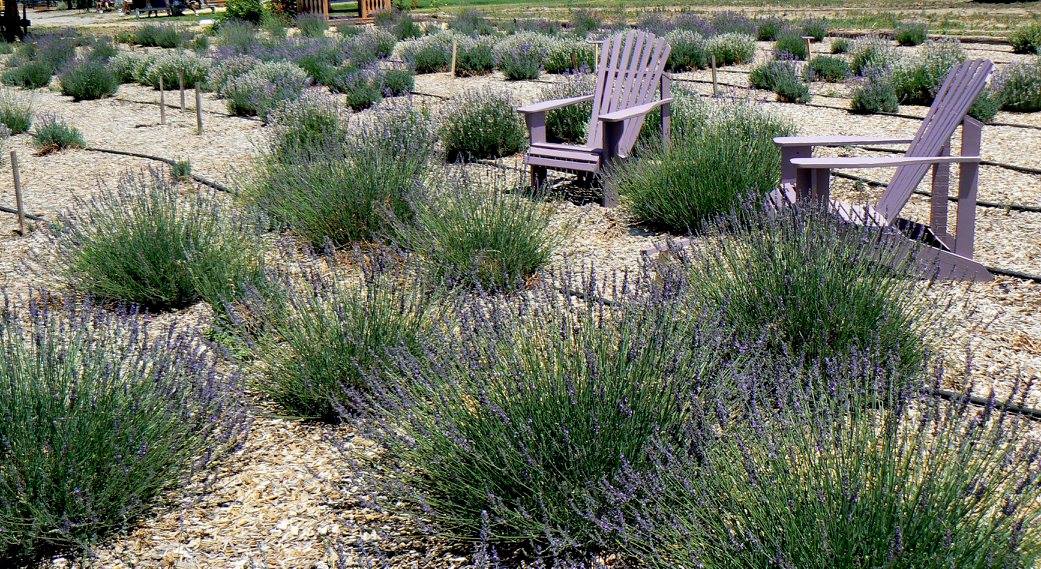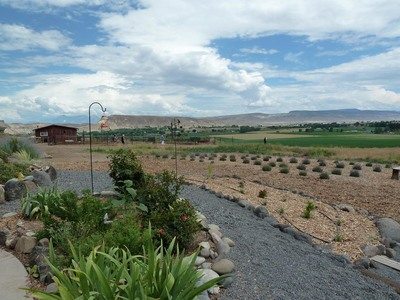
- info@coloradolavender.org
Your Cart
100% Secure Checkout!
No products in the cart.

When it comes to fertilizing, question everything I say and seek further information if what I present raises questions in your mind.
In a study from the Egyptian Journal of Horticulture, optimal yields of aerial parts of lavender were observed following fertilization with urea at 88 lb./ acre. The best yields of essential oil were observed following application of ammonium chloride (N source) at 44 lb/ acre (ElSherbany et al. 1997)
Fertilizing is talked about in Lavender: The Grower’s Guide, The Lavender Lover’s Handbook and Dr. Swift’s excellent article Soil Preparation for Lavender.
Need to know if soil is deficient in nutrients Adding nutrients when not needed can cause imbalances and do more harm than good Older plants could show signs of nutritional stress if soil is poor.
Nitrogen: main function to promote foliage growth Can help boost plant establishment when plants are first starting out (first 3 years) Too much nitrogen will boost leaf production at the expense of flower production Nitrogen application could increase stem length for cut-flower production Once plants are established using a low nitrogen fertilizer could help establish stronger roots and overall health of plants Probably want to avoid blood meal and fish emulsion on established plants as they are usually very high in nitrogen.
Phosphorus: main function to help root development and overall plant health Can be beneficial to add right before blooms begin to give the plant an extra boost Natural sources are bone meal and bat guano (need to check which kind of bat guano)
Potassium (also known as potash): key nutrient to boost plants’ tolerance to stress such as varying temperatures or long periods of drought Some growers use higher percentages of potassium to strengthen plant through winter Natural sources include composted fruits and vegetables and kelp meal
Phosphorus and potassium, however, move very little in most soils from their point of application, so it’s better to work them into the soil before planting to make sure they’ll be within the plant’s root zone.
Composts Good for adding organic matter to soil; Course composts can increase the porosity of the soil to facilitate the movement of oxygen and water to the plants roots Nutrient content not always known and usually not very concentrated .
Organic sources such as manures, guano, kelp, bone meal, etc. Need to be sure not high in soluble salts Usually low percentage so if soil is really deficient have to use large quantities.
Man-made sources – pellet or liquid Not organic certified Usually more concentrated than other sources.
In order to get maximum benefit from manures and fertilizers, they should not only be applied in proper time and in right manner but any other aspects should also be given careful consideration. Different soils react differently with fertilizer application. Similarly, the N, P, K requirements of different crops are different and even for a single a crop the nutrient requirements are not the same at different stages of growth. The aspects that require consideration in fertilizer application are listed below:
1. Availability of nutrients in manures and fertilizers.
2. Nutrient requirements of crops at different stages of crop growth.
3. Time of application.
4. Methods of application, placement of fertilizers.
5. Foliar application.
6. Crop response to fertilizers application and interaction of N, P, and K.
7. Residual effect of manures and fertilizers.
8. Crop response to different nutrient carrier.
9. Unit cost of nutrients and economics of manuring.
Fertilizers are applied by different methods mainly for 3 purposes:
1. To make the nutrients easily available to crops,
2. To reduce fertilizer losses and
3. for ease of application.
2. The time and method of fertilizer application vary in relation to
1) The nature of fertilizer.
2) Soil type and
3) The differences in nutrient requirement and nature of the crops.
Application of fertilizers in solid form: It includes the methods like:
I) Broadcasting: Even and uniform spreading of manure or fertilizers by hand over the entire surface of field while cultivation or after the seed is sown in standing crop, termed as broad casting. Depending upon the time of fertilizer application, there are two types of broadcasting:
A) Broadcasting at planting and
B) Top dressing. The term side dressing refers to the fertilizer placed beside the rows of a crop. Care must be taken in top dressing that the fertilizer is not applied when the leaves are wet or it may burn or scorch the leaves. Side-dressings could be washed from the crop in run-off or leached below the root zone.
‘Fertigation’ is the technique of supplying dissolved fertiliser to crops through an irrigation system. When combined with an efficient irrigation system nutrients and water can be manipulated and managed to obtain the maximum possible yield of marketable production from a given quantity of these inputs. Continuous small applications of soluble nutrients overcome problems of the fertilizer being washed away or going too deep, save labor, reduce compaction in the field, result in the fertiliser being placed around the plant roots uniformly and allow for rapid uptake of nutrients by the plant. To capitalize on these benefits, particular care should be taken in selecting fertilisers and injection equipment as well as in the management and maintenance of the system. Can get soluble fertilizers as either organic or man-made Need to make sure that the sources of nutrients are compatible with the plants being fertilized and with the water being used Modern fertigation should be able to regulate:
The three usual methods of injection are:
1. suction injection
2. pressure differential injection
3. pump injection.
Most common Pluses and minuses to each method of injection The effectiveness of fertigation is often dependent on the effectiveness of the irrigation system. The full advantages of irrigation and fertigation only become evident if the correct irrigation design is employed to meet plant requirements and to distribute water and fertiliser evenly. Because of the corrosive nature of many fertilisers, the components of the irrigation system that come into contact with corrosive solutions should consist of stainless steel, plastic or other noncorrosive materials. Fertigation increases the quantity of nutrients present in an irrigation system and this can lead to increased bacteria, algae and slime in the system. These should be removed at regular intervals by injection of chlorine or acid through the system. Chlorine injection should not be used while fertiliser is being injected into the system as the chlorine may tie up these nutrients making them unavailable to the plant. Systems should always be flushed of nutrients before completion of irrigation. Before commencing a fertigation program, check fertiliser compatibilities and solubility.
During the irrigation season it is important to monitor:
Foliar fertilizers are dilute fertilizer solutions applied directly to plant leaves. As with soil application of fertilizer, the goal of foliar fertilization is to supply plants with the nutrients needed for good growth. There are many products on the market that can be used as foliar fertilizers, but are they really needed? Is there any advantage to foliar application instead of soil application?
The major pathway for nutrient uptake is by way of the roots. Leaves have a waxy cuticle, which actually restricts the entry of water, nutrients, and other substances into the plant. To a limited extent nutrients applied to leaves can be absorbed and used by the plant, but for the major nutrients (nitrogen, phosphorus, potassium) the quantity absorbed at any one time is small relative to plant needs. That means that foliar application of these three nutrients can only supply a very small fraction of the total needed by the plant, so foliar application should be considered only a supplement to regular soil application of these nutrients. If the plant already has plenty of nitrogen, phosphorus, potassium, foliar application will not have any beneficial effects. In fact, if concentrations of nutrients in the foliar spray are too high, then leaf damage can occur and in severe cases may kill the plant.
When liquid fertilizer is sprayed on foliage some nutrients are absorbed through the leaves and light, frequent applications would constitute true foliar fertilization. However, with heavier spraying there will be considerable runoff from the foliage and the liquid fertilizer will soak into the soil. In this case there would be some nutrient absorption through leaves, but the majority of the nutrients used by the plant would actually be taken up by roots. From the plant’s perspective, this is essentially the same process that occurs when dry fertilizer is added to the soil. It will be more expensive and time consuming than a dry fertilizer application. Phosphorus and potassium, however, move very little in most soils from their point of application, so it’s better to work them into the soil before planting to make sure they’ll be within the plant’s root zone.
An appropriate time to consider foliar fertilization is when a specific nutrient shortage is evident based on visual symptoms or soil analysis. If a deficiency exists, then foliar application would be one means of providing a quick but temporary fix to the problem. Certain soil conditions such as high pH, low pH, drought, excessive moisture, or cool temperatures may cause some nutrients to be unavailable for uptake by the roots. If any one of these conditions exists, the problem may be more effectively corrected with foliar applications than with soil applications.
A classic example of effectively using foliar fertilizers is for micronutrients such as iron. At high soil pH levels, iron is not available to plant roots even though high levels of iron may be present in the soil. Under high pH conditions, iron chlorosis or interveinal yellowing occurs on young leaves. A way to alleviate the chlorosis temporarily is to apply inorganic salts such as iron sulfate or chelated forms of iron directly to the leaves. Chelates are chemical compounds that help iron stay in solution over a wide pH range.
The cuticle on leaves of most plants will cause water to bead up and prevent good penetration. So, for all foliar applied products, it is important to include a wetting agent or surfactant to allow for full coverage of the leaf. If rain occurs shortly after an application, most of the spray will be washed off the leaves and reapplication will be necessary.
1. Routine use of foliar fertilizers without a documented need is not recommended.
2. Foliar fertilization is unable to meet the total plant requirements for the major nutrients nitrogen, phosphorus, and potassium.
3. Foliar fertilizers are most effective when soil problems occur that restrict nutrient availability such as iron availability in high pH soils.
4. Foliar fertilization should not be used as a substitute for good soil fertility management. Have your soil tested and fertilize according to soil test recommendations.